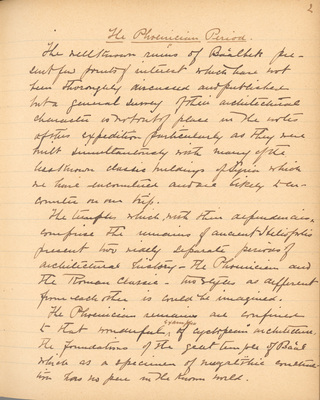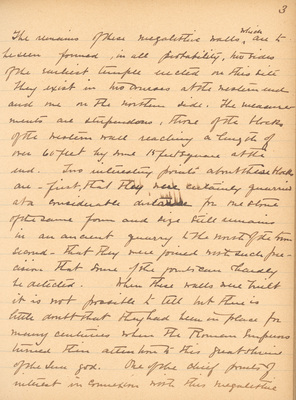Pages
BSY_FB_03-01
BSY_FB_03-01insert
03 [Insert]
[ILLUSTRATIONS]
Plan of the Temples as They Were
Plan of the Temples as They Now Stand
BSY_FB_03-02
2 The Phoenecian Period
The well known ruins of Ba'albek present few points of interest which have not been thoroughly discussed and published into a general survey of their architectural character is not out of place in the notes of this expedition particularly as they were built simultaneously with many of the less known classic buildings of Syria which we have encountered and are likely to encounter on our trip.
The temples which, with their dependencies comprise the remains of ancient Heliopolis present two widely disparate periods of architectural history - the Phoenician and the Roman Classic - two styles as different from each other as could be imagined.
The Phoenician remains are confined to that wonderful example of Cyclopean architecture, the foundations of the great temple of Ba'al which as a specimen of Megalithic construction has no peer in the Roman world.
BSY_FB_03-03
3 The remains of these Megalithic walls which are to be seen formed, in all probability, two sides of the earliest temple erected on this site. They exist in two courses at the western end and one on the northern side. The measurements are stupendous, those of the blocks of the western wall reaching a length of over 60 feet by some 15 feet square at the end. Two interesting points about these blocks are - first, that they were certainly quarried at a considerable distance for the stone of the same form and size still remains in an ancient quarry to the north of the town. Second - that they were joined with such precision that some of the joins can hardly be detected. When these walls were built it is not possible to tell but there is little doubt that they had been in place for many centuries when the Roman Emperors turned their attention to this great shrine of the Sun god. One of the chief points of interest in connexion with this Megalithic
BSY_FB_03-04
4 architecture is the bearing which it seems to have had upon all the subsequent constructive science of Syria. If we grant that this style was originated by the Phoenicians it is plain that the inhabitants of Syria who were doubtless intimately connected then learned from them their methods of building.
Building actively seems to have been somewhat checked along these lines during the Seleucid period but the Romans when they came to rebuild the temble of Ba'albek learned the art of colossal building and practiced it in Syria as they did nowhere else.
And in other parts of Syria where architecture flourished from the first century B.C. to the seventh A.D. we find this same use of huge blocks of stone as we find it in no other part of the world.
From this we argue that the native Syrians themselves had learned the art of Megalithic construction and, whether taught design by Greek or Roman artists, still employed the





